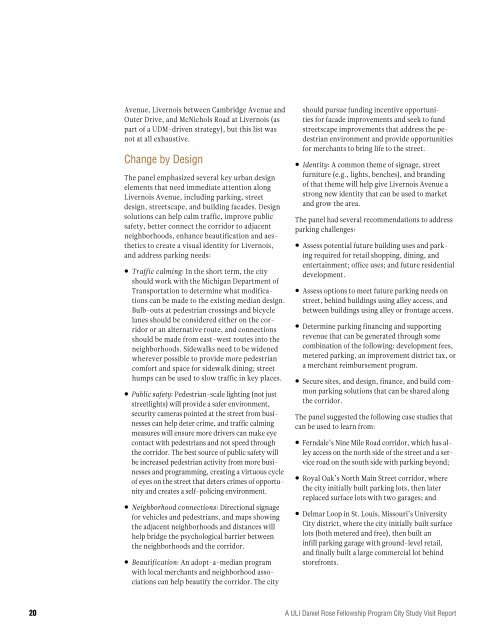Detroit Michigan
Detroit Michigan
Detroit Michigan
Create successful ePaper yourself
Turn your PDF publications into a flip-book with our unique Google optimized e-Paper software.
Avenue, Livernois between Cambridge Avenue and<br />
Outer Drive, and McNichols Road at Livernois (as<br />
part of a UDM-driven strategy), but this list was<br />
not at all exhaustive.<br />
Change by Design<br />
The panel emphasized several key urban design<br />
elements that need immediate attention along<br />
Livernois Avenue, including parking, street<br />
design, streetscape, and building facades. Design<br />
solutions can help calm traffic, improve public<br />
safety, better connect the corridor to adjacent<br />
neighborhoods, enhance beautification and aesthetics<br />
to create a visual identity for Livernois,<br />
and address parking needs:<br />
Traffic calming: In the short term, the city<br />
should work with the <strong>Michigan</strong> Department of<br />
Transportation to determine what modifications<br />
can be made to the existing median design.<br />
Bulb-outs at pedestrian crossings and bicycle<br />
lanes should be considered either on the corridor<br />
or an alternative route, and connections<br />
should be made from east–west routes into the<br />
neighborhoods. Sidewalks need to be widened<br />
wherever possible to provide more pedestrian<br />
comfort and space for sidewalk dining; street<br />
humps can be used to slow traffic in key places.<br />
Public safety: Pedestrian-scale lighting (not just<br />
streetlights) will provide a safer environment,<br />
security cameras pointed at the street from businesses<br />
can help deter crime, and traffic calming<br />
measures will ensure more drivers can make eye<br />
contact with pedestrians and not speed through<br />
the corridor. The best source of public safety will<br />
be increased pedestrian activity from more businesses<br />
and programming, creating a virtuous cycle<br />
of eyes on the street that deters crimes of opportunity<br />
and creates a self-policing environment.<br />
Neighborhood connections: Directional signage<br />
for vehicles and pedestrians, and maps showing<br />
the adjacent neighborhoods and distances will<br />
help bridge the psychological barrier between<br />
the neighborhoods and the corridor.<br />
Beautification: An adopt-a-median program<br />
with local merchants and neighborhood associations<br />
can help beautify the corridor. The city<br />
should pursue funding incentive opportunities<br />
for facade improvements and seek to fund<br />
streetscape improvements that address the pedestrian<br />
environment and provide opportunities<br />
for merchants to bring life to the street.<br />
Identity: A common theme of signage, street<br />
furniture (e.g., lights, benches), and branding<br />
of that theme will help give Livernois Avenue a<br />
strong new identity that can be used to market<br />
and grow the area.<br />
The panel had several recommendations to address<br />
parking challenges:<br />
Assess potential future building uses and parking<br />
required for retail shopping, dining, and<br />
entertainment; office uses; and future residential<br />
development.<br />
Assess options to meet future parking needs on<br />
street, behind buildings using alley access, and<br />
between buildings using alley or frontage access.<br />
Determine parking financing and supporting<br />
revenue that can be generated through some<br />
combination of the following: development fees,<br />
metered parking, an improvement district tax, or<br />
a merchant reimbursement program.<br />
Secure sites, and design, finance, and build common<br />
parking solutions that can be shared along<br />
the corridor.<br />
The panel suggested the following case studies that<br />
can be used to learn from:<br />
Ferndale’s Nine Mile Road corridor, which has alley<br />
access on the north side of the street and a service<br />
road on the south side with parking beyond;<br />
Royal Oak’s North Main Street corridor, where<br />
the city initially built parking lots, then later<br />
replaced surface lots with two garages; and<br />
Delmar Loop in St. Louis, Missouri’s University<br />
City district, where the city initially built surface<br />
lots (both metered and free), then built an<br />
infill parking garage with ground-level retail,<br />
and finally built a large commercial lot behind<br />
storefronts.<br />
20 A ULI Daniel Rose Fellowship Program City Study Visit Report


